Content
Published:
This is an archived release.
Fall in manufacturing turnover in the last quarter of 2016
Total manufacturing turnover decreased 2.1 per cent in the forth quarter compared to the third quarter of 2016. However, it was almost unchanged from November to December.
| Seasonally adjusted | Calendar adjusted1 | Unadjusted | ||
|---|---|---|---|---|
| Monthly change | Three-month change | Twelve-month change | NOK million | |
| December 2016 / November 2016 | October 2016 - December 2016 / July 2016 - September 2016 | December 2016 / December 2015 | December 2016 | |
| 1Adjusted for working-days and for public holidays in Norway. | ||||
| Extraction, mining, manufacturing and elec | 0.2 | 3.7 | 3.7 | 131 415 |
| Extraction and related services | 5.8 | 10.1 | 10.0 | 52 004 |
| Mining and quarrying | 14.4 | -17.6 | -10.7 | 910 |
| Manufacturing | -0.2 | -2.1 | -7.2 | 61 480 |
| Food, beverages and tobacco | 0.4 | 1.7 | 6.6 | 19 418 |
| Refined petro., chemicals, pharmac. | 9.1 | -4.6 | -14.8 | 8 083 |
| Basic metals | -0.5 | -0.7 | 5.9 | 4 709 |
| Machinery and equipment | -0.3 | -21.2 | -46.1 | 3 428 |
| Ships, boats and oil platforms | -14.1 | 1.9 | -28.2 | 4 054 |
| Electricity, gas and steam | -16.5 | 14.8 | 37.0 | 17 020 |
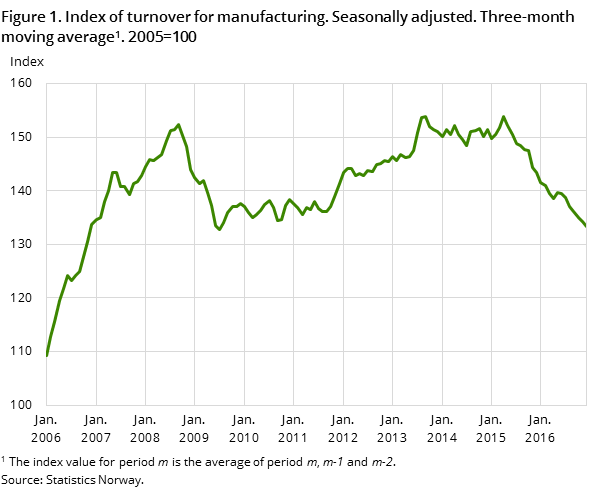
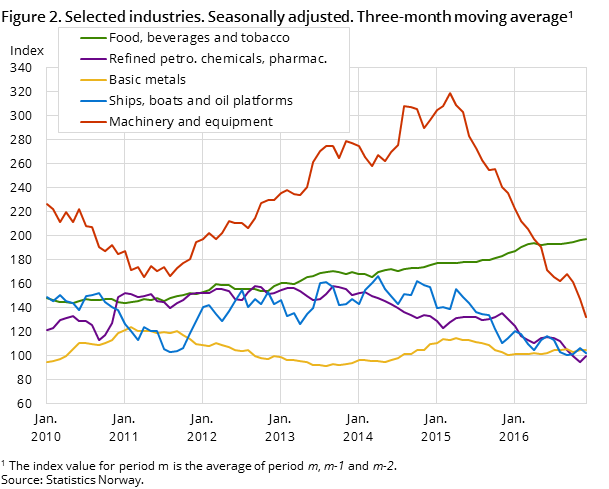
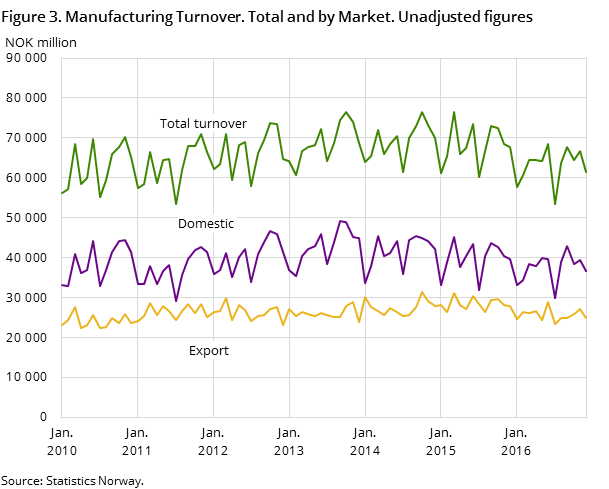
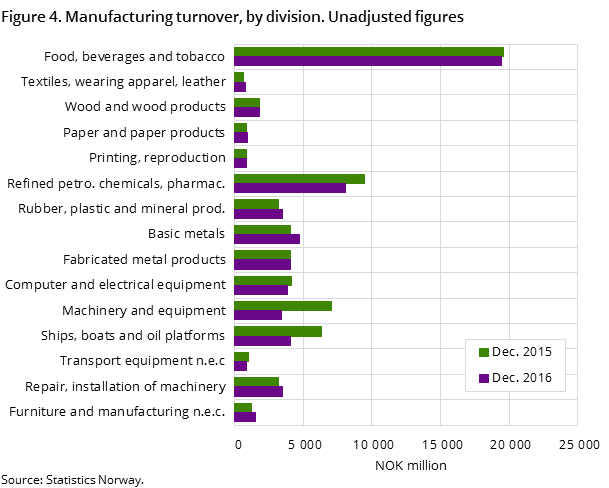
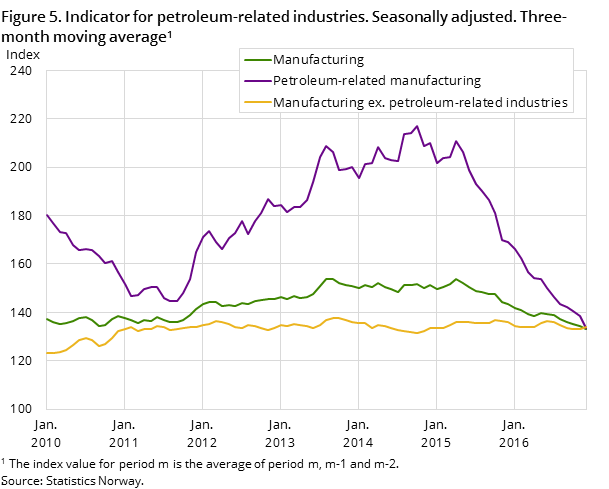
The index value for turnover in manufacturing was 133.3 (2005=100) in the forth quarter of 2016, compared to 136.2 in the third quarter, according to seasonally-adjusted figures.
Three-month change: pronounced fall for suppliers to the oil and gas sector industries
A 2.1 per cent decline in the total turnover is mainly due to the reduced activities among the suppliers to the oil and gas sector industries, where the machinery and the equipment industry posted the largest decrease. This was followed by fabricated metal products, which went down significantly. Moreover, the grouping refined petroleum, chemical and pharmaceutical industries edged down in this period.
Conversely, food products, textile wearing apparels and leather in addition to repair, installation of machinery recorded an increase and partially offset the decline in total turnover in the last quarter of 2016.
Monthly change: stable manufacturing turnover from November to December
Total Norwegian manufacturing turnover went down 0.2 per cent from November to December 2016, according to seasonally-adjusted figures. Despite the unchanged total turnover, some of the industries showed notable changes, both positive and negative. The following industries showed a growth and contributed most to curb the decline in total turnover:
• Grouping refined petroleum, chemical and pharmaceutical
• Rubber, plastic and mineral products
• Repair, installation of machinery
Several large deliveries registered in November led to a decline in building of ships, boats and oil platforms. With a decline in fabricated metal products, these two industries were the biggest contributors to pulling down total turnover.
Annual change: 2016, a tough year for manufacturing
The turnover in Norwegian manufacturing showed a negative annual change of 7.5 per cent from 2015 to 2016. Both the domestic and export market showed a downturn. Statistics Norway will publish a separate article regarding annual changes in manufacturing turnover in 2016 on Tuesday, 21st February 2017.
Monthly change: growth in the euro area, slight increase in Norway
Norwegian manufacturing turnover went up 0.4 per cent from October to November 2016, according to seasonally-adjusted figures. Manufacturing turnover in the euro area showed an increase of 1.5 per cent. Among the Nordic countries, Denmark rose 3.4 per cent, and Sweden edged up 0.9 per cent, according to Eurostat.
Find more figures
Find detailed figures from Turnover in oil and gas, manufacturing, mining and electricity supply
Additional information
The variation in manufacturing turnover can be related to changes in volume and price indices in different industries and also production to stocks and sales from stocks.
Contact
-
Robert Skotvold
E-mail: robert.skotvold@ssb.no
tel.: (+47) 40 90 24 44
-
Anne Karin Linderud Haugen
E-mail: anne.karin.linderud.haugen@ssb.no
tel.: (+47) 91 88 19 76
